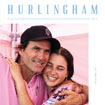From High Goal to Hollywood – the history of polo in the USA – Part 3
By Victoria Elsbury-Legg
Click here for part 2
During the formative years of polo being played in America under the rules of the USAP it was Foxhall Keene’s name who was on everyone’s lips, for he was the legend on the pitch and the man who played off 10 goals for 14 years, then 9 goals for a further 16 years. From 1890 – 1920’s also standing out amongst the many highly competitive players were four men who seemed destined to not only win, but also to become known as the ‘Big Four’ – Devereux Milburn, brothers Larry and Monty Waterbury and the man who was at the forefront of US polo during this time – Harry Payne Whitney. His was also a style of open, running play (which differed from the shorter passes of European players) increased teamwork and changed the very nature of the sport as teammates galloped the length of the pitch to pick up much longer passes. His was also to be an enduring polo legacy with his surname still remaining very much at the forefront of US high goal polo today, with his son Cornelius Vanderbilt following in this father’s hoof prints, the C.V. Whitney Cup (which was first played in 1979) is now the tournament that annually begins the American High Goal Triple Crown, currently played at the International Polo Club Palm Beach.
Born into two of the prominent and wealthy American families of the time (Whitney and Vanderbilt) Cornelius Vanderbilt ‘Sonny’ Whitney (1899 – 1992), alongside his cousin John Hay Whitney were to become two of the most well-known US patrons of the 1930’s. With a father whose name graces the Polo Hall of Fame, it was small surprise that C.V. Whitney and his team went on to win the US Open three times. Indeed his whole life seemed to embody the true spirit of the polo players of his generation who were capturing the imagination of the public. He demonstrated not only great determination and entrepreneurship on the pitch, but also off it. In business he was fundamental in establishing the Aviation Corporation of America (Pan American World Airways), he was a writer, philanthropist and official in government. For many decades he was also a highly respected breeder and owner of one of the top stables of thoroughbred racehorses, not to mention being a main shareholder in the Technicolour Corporation which made him one of the key backers of Gone with the Wind in 1939.
His was an era when polo flourished and the patrons rode off not only fellow business colleagues, but also the stars of Hollywood. Between the war years, in the 1930’s the glitz of the silver screen also found its way onto the polo pitch, as polo grew in popularity in California. In 1933 an East – West match was played, with two of the three matches being won by the West, play got so intense on the pitch near Chicago that both players sporting number 3 shirts (Tommy Hitchcock and Cecil Smith) were not only knocked unconscious, but insisted on remounting and returning to the field to play alongside Rube Williams (West team) who suffered a broken leg during a ride-off. Leading Humorist of the time Will Rogers, a keen polo player and avid supporter of the sport, to famously remark ‘The hillbillies beat the dudes and took the polo championship right out of the drawing room and into the bunkhouse.’
Click here for part 4


